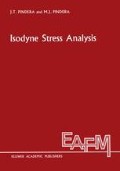Abstract
The ultimate objective of stress analysis, both analytical and experimental, is the determination of the following quantities pertaining to the responses of real bodies:
-
stresses, which represent forces acting inside a body;
-
strains, which represent local deformations, both linear and angular;
-
displacements, which represent movements of sets of particles of a body such as points, lines, squares, referred to a chosen coordinate system which is independent of the body.
Access this chapter
Tax calculation will be finalised at checkout
Purchases are for personal use only
Preview
Unable to display preview. Download preview PDF.
References
Kiesling, E. W. and Pindera, J. T., “Linear Limit Stresses of Some Photoelastic and Mechanical Model Materials”, Experimental Mechanics 9 (8), 1969, pp. 337–347.
Pindera, J. T., Rheological Photoelastic Properties of Some Polyester Resins (in Polish), Parts 1, 2, and 3, Engineering Transactions (Rozprawy Inzynierskie), Polish Acad. Sciences, Vol. 7, (3, 4), 1959, pp. 361–411, 481–520, 521–540.
Pindera, J. T., “Some Rheological Problems of Photoelastic Investigations” (in German), in: G. Haberland (Ed.), Internationales spannungsoptisches Symposium (Berlin, April 10–15, 1961 ), Akademie-Verlag, Berlin, 1962, pp. 155–172.
Pindera, J. T., Rheological Properties of Model Materials (in Polish), Wydawnictwa Naukowo-Techniczne, Warszawa, 1962.
Pindera, J. T., “Remarks on Properties of Photoviscoelastic Model Materials”, Experimental Mechanics 7 (6), 1967, pp. 375–380.
Pindera, J. T. and Kiesling, E W, On the Linear Range of Behaviour of Photoelastic and Model Materials, VDI-Berichte No. 102, Experimentelle Spannungsanalyse, VDI-Verlag, Dusseldorf, 1966, pp. 89–94.
Pindera, J. T. and Cloud, G., “On Dispersion of Birefringence of Photoelastic Materials”, Experimental Mechanics 6 (9), 1966, pp. 470–480.
Pindera, J. T., “On Physical Basis of Modern Photoelasticity Techniques”, Beiträge zur Spannungs-und Dehnungsanalyse, Vol. V, Akademie-Verlag, Berlin, 1968, pp. 103–130.
Pindera, J. T. and Sinha, N. K., “On the Studies of Residual Stresses in Glass Plates”, Experimental Mechanics 11 (3), 1971, pp. 113–120.
Pindera, J. T., “On the Transfer Properties of Photoelastic Systems”, in: N. J. Prigorovski and H. K. Aben (Eds.), Proc. of the 7th All-Union Conference on Photoelasticity, Akademia Nauk Estonskoy SSR, Tallinn, 1971, pp. 48–63.
Pindera, J. T. and Sinha, N. K., “Determination of Dominant Radiation in Polariscope by Means of Babinet Compensator”, Experimental Mechanics 12 (1), 1972, pp. 1–5.
Pindera, J. T. and Straka, P., “Response of the Integrated Polariscope”, Journal of Strain Analysis 8 (1), 1973, pp. 65–76.
Pindera, J. T., “Response of Photoelastic Systems”, Trans. of the CSME 2, 1973–74, pp. 21–30.
Pindera, J. T. and Straka, P., “Mechanical and Dielectric Rheological Responses of Some High Polymers in Wide Temperature and Spectral Frequency Ranges”, in: J. T. Pindera et al. (Eds.), Experimental Mechanics in Research and Development, Solid Mechanics Division, Study No. 9, 1973, pp. 601–615.
Pindera, J. T. and Straka, P., “On Physical Measures of Rheological Responses of Some Materials in Wide Ranges of Temperature and Spectral Frequency”, Rheologica Acta 13 (3), 1974, pp. 338–351.
Pindera, J. T., Straka, P., and Krishnamurthy, A. R., “Rheological Responses of Materials Used in Model Mechanics”, in: G. Bartolozzi (Ed.), Proc. of the Fifth International Conference on Experimental Stress Analysis, CISM, Udine, 1974, pp. 2. 85–2. 98.
Pindera, J. T. and Krishnamurthy, A. R., “Characteristic Relations of Flow Birefringence, Part 1: Relations in Transmitted Radiation”, Experimental Mechanics 18 (1), 1978, pp. 1–10.
Pindera, J. T. and Krishnamurthy, A. R., “Characteristic Relations of Flow Birefringence, Part 2: Relations in Scattered Radiation”, Experimental Mechanics 18 (2), 1978, pp. 41–48.
Pindera, Jerzy T., “Foundations of Experimental Mechanics: Principles of Modelling, Observation and Experimentation”, in: Pindera, J. T. (Ed.), New Physical Trends in Experimental Mechanics, Springer-Verlag, Wien, 1981, pp. 188–326.
Pindera, J. T. and Krasnowski, B. R., “Rheological Factors in Theory of Isodyne Methods for Determination of Stress/Strain States in Composite Materials and Structures”, in: Proc. of the IX International Congress on Rheology,Acapulco, Gro., Mexico, October 8–12, 1984. Advances in Rheology. Vol. 3: Polymers, pp. 741–748.
Author information
Authors and Affiliations
Rights and permissions
Copyright information
© 1989 J. T. Pindera and Sons Engineering Services, Ontario, Canada
About this chapter
Cite this chapter
Pindera, J.T., Pindera, MJ. (1989). Theory of isodyne experiments. In: Isodyne Stress Analysis. Engineering Application of Fracture Mechanics, vol 8. Springer, Dordrecht. https://doi.org/10.1007/978-94-009-0973-1_6
Download citation
DOI: https://doi.org/10.1007/978-94-009-0973-1_6
Publisher Name: Springer, Dordrecht
Print ISBN: 978-94-010-6927-4
Online ISBN: 978-94-009-0973-1
eBook Packages: Springer Book Archive

